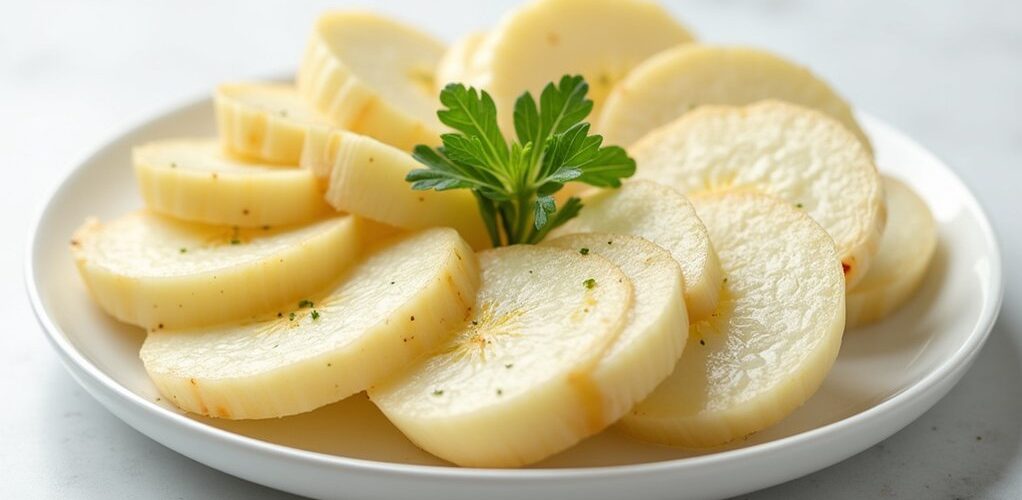
Turnips are indeed a low-carb vegetable, containing only 6.43 grams of carbohydrates per 100 grams, with approximately 4.63 grams of net carbs after subtracting fiber content. This root vegetable offers considerably fewer carbohydrates compared to potatoes, carrots, and sweet potatoes, making it an excellent alternative for low-carb diets. Turnips provide essential nutrients, including vitamin C and fiber, while maintaining a low caloric profile at 51 calories per cooked cup. Understanding turnip's versatility in cooking methods opens up countless nutritious meal possibilities.
Key Takeaways
- Turnips contain only 6.43g of carbohydrates per 100g, making them a low-carb vegetable choice compared to starchy alternatives.
- A medium turnip provides approximately 6g of net carbs per serving, ideal for low-carb and keto diets.
- Raw turnips have just 4.63g net carbs per 100g serving after subtracting 1.8g of dietary fiber.
- Turnips are significantly lower in carbs than potatoes (17g), sweet potatoes (20g), and other starchy vegetables.
- A cup of cooked mashed turnips contains less than 12g carbs and only 51 calories, perfect for carb-conscious meals.
The Truth About Turnip's Carbohydrate Content
The carbohydrate content of turnips makes them an excellent choice for individuals following low-carb dietary protocols. With approximately 6.43 grams of carbohydrates per 100 grams, turnips stand out among keto-friendly vegetables for their minimal carb impact. A medium turnip contains roughly 6 grams of net carbs per serving, positioning it as a practical low-carb alternative to starchier vegetables. For those monitoring their carbohydrate intake, turnips prove especially valuable in their cooked form, containing less than 12 grams of carbohydrates per cup when mashed. This characteristic, combined with reduced raffinose levels after cooking, makes turnips particularly suitable for ketogenic and low-carb diets. Their modest carbohydrate profile allows for generous portions while staying within daily carb limits. Adding leafy greens like spinach to meals alongside turnips can further enhance nutrient intake and support overall health on a keto diet.
Understanding Net Carbs in Turnips
When examining turnip's net carb content, it's essential to understand that a medium turnip contains just 6g of net carbs, calculated by subtracting fiber from total carbohydrates.
Raw turnips offer approximately 4.63g of net carbs per 100g serving, making them an excellent choice for low-carb dietary plans.
The cooking process can further reduce the net carb content by breaking down complex sugars, while also enhancing digestibility and making turnips more versatile for various meal preparations.
Calculating Turnip Carb Content
Understanding net carbs in turnips requires calculating the difference between total carbohydrates and dietary fiber content. For a medium-sized turnip weighing approximately 4 ounces, the net carb content is around 6 grams, making it an excellent low-carb vegetable choice.
To calculate the carb content more precisely, consider that every 100 grams of turnips contains 6.43 grams of total carbohydrates, with 1.8 grams being dietary fiber. This calculation is particularly relevant for those following ketogenic or low-carb diets, where tracking carbohydrate intake is essential.
When compared to starchy vegetables like potatoes, turnips offer considerably fewer carbohydrates while still providing satisfying bulk to meals. Additionally, cooking turnips helps reduce their raffinose content, making them easier to digest while maintaining their low-carb status.
Raw Vs Cooked Carbs
Raw and cooked turnips present different carbohydrate profiles, making their comparison valuable for those monitoring their carb intake.
Understanding the raw vs cooked differences helps in making informed dietary choices, particularly for those following low-carb eating plans.
- Raw turnips contain 6.43g total carbs and 1.8g fiber per 100g serving, resulting in 4.63g net carbs.
- Cooked mashed turnips have 12g total carbs and 5g fiber per cup, yielding 7g net carbs.
Cooking reduces raffinose content, improving digestibility while remaining low in carbohydrates.
Both raw and cooked forms are high in fiber, supporting digestive health.
The cooking process mellows the vegetable's strong flavor while maintaining its status as a keto-friendly option.
These variations in carbohydrate content allow for flexible meal planning while staying within daily carb limits.
Turnips vs. Other Root Vegetables: A Carb Comparison
For those seeking low-carb alternatives to traditional root vegetables, turnips stand out as a particularly lighter option in the carbohydrate department. When comparing carb content across common root vegetables, turnips contain just 6.43g of carbs per 100g serving, making them an excellent choice for low-carb diets. A significant advantage of incorporating turnips into a ketogenic diet is their ability to contribute to steady blood sugar levels, which is crucial for individuals managing diabetes.
| Root Vegetable | Carbs (g/100g) | Low-Carb Friendly |
|---|---|---|
| Turnips | 6.43 | Yes |
| Carrots | 9.60 | Moderate |
| Beets | 10.00 | Moderate |
| Potatoes | 17.00 | No |
| Sweet Potatoes | 20.00 | No |
This significant difference in carbohydrate content positions turnips as an ideal substitute for higher-carb options like potatoes and sweet potatoes, particularly for those monitoring their carbohydrate intake or following ketogenic dietary patterns.
Health Benefits of Adding Turnips to Low-Carb Diets
Beyond their favorable carbohydrate profile, turnips offer a wealth of health advantages that make them an exceptional addition to low-carb dietary plans. The health benefits of incorporating turnips into a low-carb lifestyle extend far beyond their minimal carbohydrate content.
- Supports digestive health with 5 grams of fiber per cooked cup
- Enhances immune function through high vitamin C content
- Promotes cardiovascular wellness and improved heart health
- Aids hydration with nearly 90% water content
- Provides antioxidant protection against oxidative stress
These nutritional attributes make turnips a valuable component of any low-carb eating plan, offering extensive support for overall wellness while helping maintain carbohydrate restrictions.
Their versatility in cooking applications, combined with their impressive nutritional profile, positions turnips as an ideal vegetable choice for health-conscious individuals following carbohydrate-restricted diets.
Best Ways to Prepare Low-Carb Turnip Dishes
Preparing turnips in various ways can maximize their potential as a low-carb ingredient while enhancing their natural flavors.
Roasting turnips with garlic and herbs brings out their sweetness, while mashing them creates a creamy alternative to high-carb potatoes, both methods keeping net carbs to approximately 5 grams per serving.
Raw turnips can be grated into salads for a crisp texture and peppery kick, offering a fresh approach to incorporating this versatile root vegetable into low-carb meal plans.
Roasting For Maximum Flavor
Roasting turnips transforms these humble root vegetables into a delectable low-carb side dish bursting with caramelized flavors and crispy textures.
For ideal results, roasting at 425°F (220°C) enhances their natural sweetness while maintaining a low carb count of just 5g net carbs per serving.
- Toss turnip cubes with olive oil, salt, and herbs before roasting
- Cook for 25-30 minutes until caramelized outside and tender inside
- Add garlic and rosemary for enhanced flavor and health benefits
- Consider using Gilfeather turnips for a naturally sweeter taste
- Guarantee even-sized pieces for consistent roasting results
The combination of high heat and olive oil creates the perfect environment for developing rich flavors while keeping the dish firmly in the low-carb category, making roasted turnips an excellent alternative to higher-carb potato dishes.
Mashed Turnip Alternatives
While roasting brings out exceptional flavors in turnips, mashed preparations offer equally enticing low-carb possibilities for health-conscious cooks. This versatile root vegetable, low in calories and an excellent source of vitamins, can be transformed into creamy mashed turnips that contain only 5 grams of net carbs per serving, making it an ideal low-carb alternative to traditional potato-based sides.
| Preparation Method | Net Carbs (g) | Cooking Time | Key Benefits |
|---|---|---|---|
| Classic Mash | 5.0 | 20 min | Creamy texture |
| Turnip-Cauli Blend | 4.5 | 25 min | Extra smooth |
| Garlic-Herb Mash | 5.2 | 20 min | Enhanced flavor |
| Turnip-Greens Mix | 4.8 | 25 min | Added nutrients |
For best results, boil peeled turnips until tender, then combine with butter, cream, and preferred seasonings to create a satisfying, low-carb comfort food option.
Raw Turnip Serving Tips
Raw turnips offer remarkable versatility in low-carb meal preparation, with their crisp texture and subtle peppery notes making them an excellent addition to various dishes.
At just 6g of net carbs per medium turnip, they provide numerous nutritional benefits while supporting healthy snacking goals.
Here are practical ways to incorporate raw turnips into your low-carb lifestyle:
- Grate fresh turnips into salads for added crunch and flavor
- Create vibrant slaws by combining with other low-carb vegetables
- Slice thinly for nutritious vegetable platters with dips
- Pair with healthy fats like olive oil or avocado to enhance taste
- Add to mixed vegetable medleys for extra texture and nutrients
These serving suggestions make it easy to enjoy raw turnips while maintaining a low-carb eating plan.
Turnips as a Potato Substitute: What You Need to Know
For health-conscious individuals seeking alternatives to high-carb staples, turnips emerge as an excellent potato substitute in many dishes. While starchy vegetables like potatoes pack substantial carbohydrates, turnips are low in carbs, containing only 6g per medium-sized portion. Their versatility makes them ideal when used as a substitute in traditional potato-based recipes. The carb counts become particularly appealing when comparing mashed preparations, with turnips offering just 51 calories per cup versus potatoes at 200 calories. Turnips can be prepared in multiple ways, including roasting, boiling, or transforming them into crispy fries with only 5g of net carbs per serving. Additionally, cooking reduces their raffinose content, making them easier to digest than potatoes for many people. Incorporating turnips into a low-carb diet provides a satisfying alternative to starchy foods, aiding in maintaining ketosis and promoting weight loss.
Seasonal Availability and Storage Tips
Understanding the seasonal availability of turnips helps shoppers make informed purchasing decisions throughout the year.
These versatile root vegetables are most abundant from late summer through early spring, with peak season occurring between September and March.
To guarantee the best quality and longest storage life, keep these essential tips in mind:
- Select firm, smooth roots without blemishes or soft spots
- Avoid turnips that show signs of sprouting or shriveling
- Remove any attached greens before storage to prevent moisture loss
- Store in a cool, dark, and humid environment, preferably in the refrigerator's crisper drawer
- For long-term storage, blanch turnips for 2-3 minutes before freezing
When properly stored in the refrigerator, fresh turnips can maintain their quality for up to two weeks, making them a convenient low-carb vegetable option.
Common Myths About Turnips and Carbohydrates
Numerous misconceptions circulate about turnips and their carbohydrate content, particularly among those following low-carb diets. Many people mistakenly believe turnips are high in carbs due to their starchy appearance and root vegetable classification.
However, scientific evidence shows that turnips contain markedly fewer carbohydrates than commonly assumed, with only 6 grams of net carbs in a medium-sized turnip.
Another prevalent myth suggests that turnips should be avoided on low-carb diets, similar to potatoes.
In reality, turnips are excellent alternatives to high-carb vegetables, containing just 12 grams of carbohydrates per cup when cooked and mashed.
Combined with their beneficial fiber content of 1.8 grams per 100-gram serving, turnips prove to be a nutritious, low-carb option for health-conscious individuals.
Turnips in Different Low-Carb Diet Plans
Low-carb diets come in many variations, each with specific guidelines for carbohydrate intake, and turnips fit remarkably well into these diverse eating plans. Their versatility and nutritional profile make them an excellent choice for various low-carb approaches.
- Ketogenic Diet: Turnips contain only 4.63g net carbs per 100g, fitting well within strict keto limits.
- Standard Low-Carb: A medium turnip provides just 6g net carbs, allowing flexible meal planning.
- Moderate Low-Carb: Higher carb allowance makes turnips even more versatile in recipes.
- Cyclical Low-Carb: Turnips provide vitamin C while maintaining lower carb counts.
- Seasonal Low-Carb: High fiber content supports digestive health while keeping net carbs low.
Additionally, turnips can aid in maintaining insulin regulation due to their low carbohydrate content, which is beneficial for appetite control and reducing hunger pangs. These adaptable root vegetables can be prepared through multiple cooking methods, making them a practical choice for any low-carb eating style.
Recipe Ideas for Low-Carb Turnip Meals
Turnip noodles, created with a spiralizer, offer a versatile base for low-carb stir-fries where they can be tossed with vegetables, protein, and Asian-inspired sauces. Mashed turnips, prepared with butter and seasonings, serve as an excellent substitute for mashed potatoes, providing the same creamy comfort with considerably fewer carbohydrates. Turnips are similar to other vegetable-based pasta alternatives such as zucchini noodles and spaghetti squash, which are low in carbs and rich in nutrients. These preparation methods showcase turnip's adaptability in low-carb cooking, while maintaining familiar textures and satisfying flavors that make the shift to lower-carb alternatives more manageable.
Turnip Noodle Stir-Fry Ideas
Creating delicious stir-fry dishes with spiralized turnip noodles offers a versatile, low-carb alternative to traditional pasta-based meals.
These noodles can be quickly prepared and combined with colorful vegetables and proteins for a nutritious dinner option.
To create an appetizing turnip noodle stir-fry, consider these key components:
- Spiralize raw turnips into noodle-like strands for the base
- Add complementary vegetables like bell peppers, broccoli, and carrots
- Season with Asian-inspired flavors such as soy sauce, garlic, and ginger
- Cook briefly to maintain ideal texture and important nutrients
- Combine with preferred protein sources for a complete meal
The mild flavor of turnip noodles makes them an excellent canvas for various stir-fry recipes, while their low carb content keeps them suitable for health-conscious diners.
Mashed Turnip Side Dishes
When seeking a comforting and versatile side dish, mashed turnips offer a delicious alternative to traditional potato-based options while maintaining considerably lower carbohydrate content. These low-carb vegetables, packed with nutrients, contain just 12 grams of carbs and 51 calories per cup when cooked and mashed.
| Recipe Style | Key Ingredients | Benefits |
|---|---|---|
| Classic | Butter, Cream | Creamy texture |
| Garlic | Minced garlic, Herbs | Enhanced flavor |
| Cheesy | Cheddar, Parmesan | Added richness |
| Keto-friendly | Sour cream, Cream cheese | Higher fat content |
| Herb-infused | Fresh herbs, Black pepper | Aromatic taste |
For ideal results, boil peeled turnips until tender, then combine with preferred ingredients to create a satisfying accompaniment to proteins like grilled chicken or fish.
Tips for Selecting and Buying Low-Carb Turnips
To guarantee the best quality and nutritional value in low-carb cooking, shoppers should focus on selecting ideal turnips at the market. When choosing turnips for a low-carb diet, several key characteristics indicate prime freshness and quality.
- Look for turnips with firm, smooth skin free from blemishes or soft spots.
- Select smaller-sized turnips, which offer sweeter flavor and less woody texture.
- Choose specimens that feel heavy for their size, indicating good moisture content.
- Avoid any turnips showing signs of sprouting or deterioration.
- Store properly in a cool, dark environment or refrigerator to maintain quality.
Following these guidelines guarantees the best turnips for low-carb meal preparation, maximizing both nutritional benefits and taste while maintaining the vegetable's natural crispness and flavor profile.
Frequently Asked Questions
Is Turnip Good for a Low-Carb Diet?
Turnips excel in low-carb diets due to their minimal carbohydrate content, strong nutritional value, and versatility in recipes. Compared to other starchy vegetables, turnips offer superior health benefits while maintaining lower carb counts.
What Is the Lowest Carb Vegetable to Eat?
Rocket (arugula) tops the list of lowest carb vegetables at 0.1g per 100g serving. Among healthy vegetable options for low carb diets, button mushrooms and watercress follow with minimal carbohydrate content.
Are Turnips Less Carbs Than Potatoes?
Turnip nutrition reveals markedly lower carbohydrates compared to potatoes. While potatoes contain 37g net carbs, turnips have only 6g, making them excellent potato alternatives for low-carb turnip recipes.
Which Root Vegetable Is Lowest in Carbs?
Among root vegetable varieties, radishes contain the lowest carbs at 1.9g per 100g, tied with celeriac. These options provide excellent nutritional benefits and work well in turnip recipes for carb comparisons.
Conclusion
Turnips prove to be an excellent choice for those following low-carb diets, containing just 4-5 net carbs per 100g serving. Their versatility in cooking, combined with significant nutritional benefits, makes them a smart alternative to higher-carb root vegetables. Whether mashed, roasted, or incorporated into various dishes, turnips offer a satisfying way to maintain carbohydrate restrictions while enjoying flavorful, wholesome meals. For best results, select fresh, firm turnips and experiment with different preparation methods.

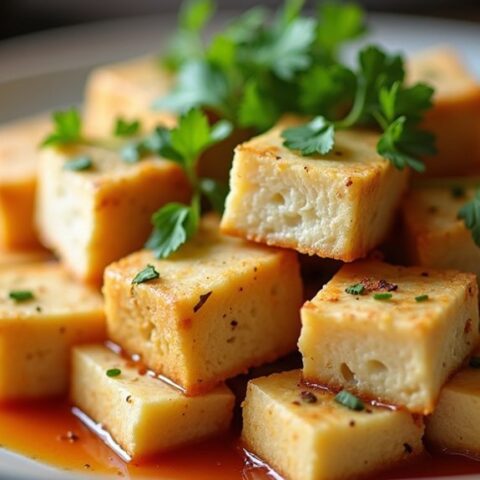
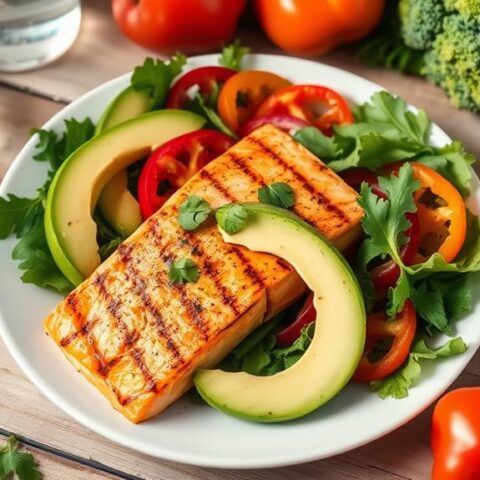

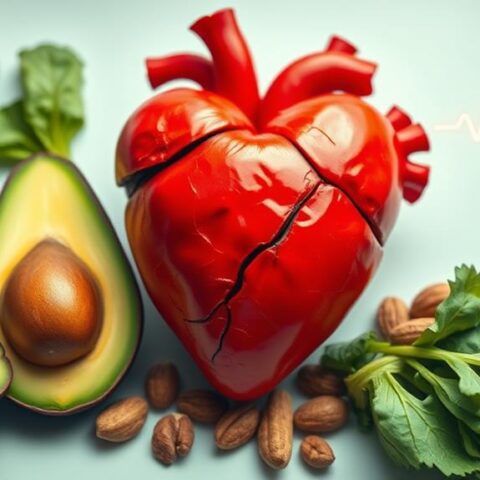
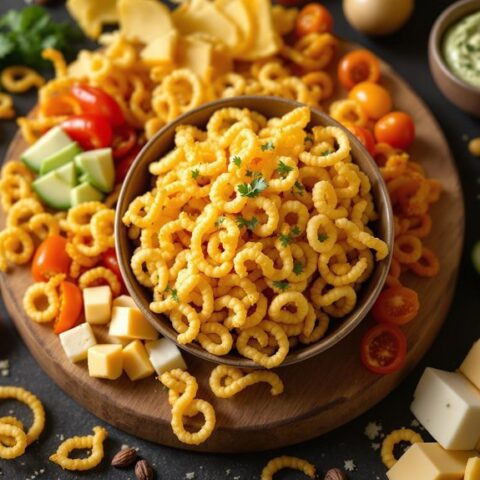
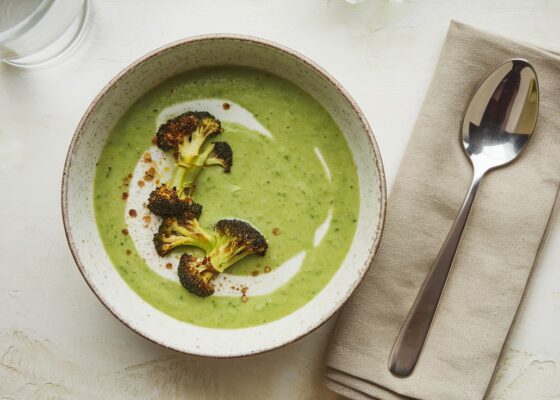

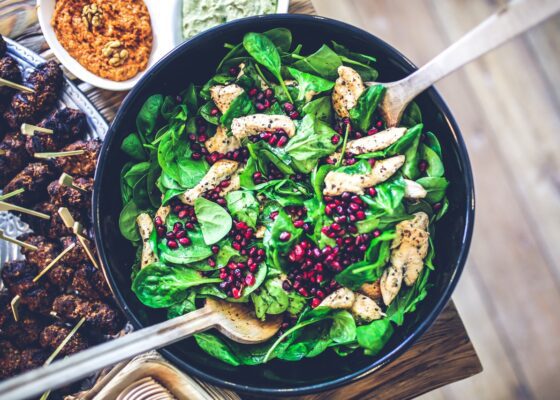

No Comments